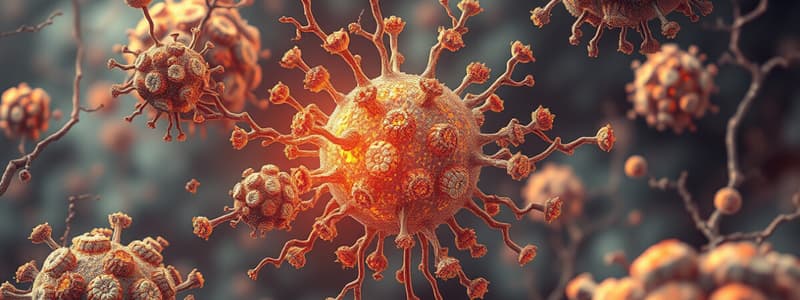Podcast
Questions and Answers
What characterizes humoral immunity primarily?
What characterizes humoral immunity primarily?
- Activation of T cells to kill infected cells
- Phagocytosis by macrophages
- Release of cytokines by neutrophils
- Production of antibodies by plasma cells (correct)
Which statement best describes cell-mediated immunity?
Which statement best describes cell-mediated immunity?
- It primarily targets extracellular pathogens
- It does not involve antigen-presenting cells
- It involves B cell activation and antibody production
- It is mediated by T cells that recognize infected cells (correct)
Which of the following phases is NOT part of adaptive immunity?
Which of the following phases is NOT part of adaptive immunity?
- Clonal expansion of lymphocytes
- Recognition of antigens
- Activation of immune cells
- Immediate response to pathogens (correct)
What role do cytokines play in the immune response?
What role do cytokines play in the immune response?
What distinguishes the adaptive immune response from the innate immune response?
What distinguishes the adaptive immune response from the innate immune response?
What defines innate immunity?
What defines innate immunity?
Which of the following is NOT a component of innate immunity?
Which of the following is NOT a component of innate immunity?
How do physical barriers contribute to innate immunity?
How do physical barriers contribute to innate immunity?
Which statement about innate immunity is accurate?
Which statement about innate immunity is accurate?
Why is innate immunity often considered a non-specific defense?
Why is innate immunity often considered a non-specific defense?
Flashcards are hidden until you start studying
Study Notes
Innate Immunity Overview
- Innate immunity serves as the body’s first line of defense against pathogens, offering rapid and non-specific protection.
- This defense mechanism does not require previous exposure to pathogens to function effectively.
Components of Innate Immunity
- Physical Barriers: Skin and mucous membranes act as barriers preventing pathogen entry.
- Cellular Defenses:
- Macrophages, neutrophils, and dendritic cells play key roles in engulfing and destroying pathogens.
- Pattern Recognition Receptors (PRRs):
- Identify and respond to pathogen-associated molecules.
- Types include:
- Toll-like Receptors (TLRs): Recognize specific microbial components.
- NOD-like Receptors (NLRs): Detect intracellular pathogens.
- C-type Lectin Receptors (CLRs): Bind carbohydrates on pathogens.
Mechanisms of Innate Immunity
- Inflammation: Initiated in response to injury or infection, increasing blood flow and immune cell recruitment.
- Phagocytosis:
- Process where immune cells ingest and eliminate microbes.
- Essential for clearing pathogens and debris.
- Complement System:
- A group of proteins that enhance the ability of antibodies and phagocytic cells to clear microbes.
- Promotes inflammation and helps lyse pathogens.
Additional Features
- Anti-microbial Proteins: Present at epithelial surfaces and in blood, these proteins provide a direct defense against pathogens.
- Infected Cell Recognition: Immune cells can identify infected cells and induce apoptosis to eliminate threats.
- Inflammatory Proteins: Enhance the inflammatory response, aiding in recruitment and activation of immune cells.
Studying That Suits You
Use AI to generate personalized quizzes and flashcards to suit your learning preferences.




